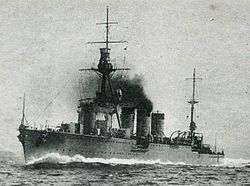Yura (ship, 1923)
|
Light cruiser Yura
|
||||||||||||||||||
|
||||||||||||||||||
|
||||||||||||||||||
|
||||||||||||||||||
|
||||||||||||||||||
The Yura ( Jap. 由良 ) was a light cruiser of the Nagara class , that of the Imperial Japanese Navy in World War II in the Pacific theater was used. The cruiser was abandoned by the crew on October 25, 1942 after severe combat damage. The ship was named after the Yura River in Kyoto .
Technique and modifications
In the course of an initial modernization from the summer of 1933 to January 1934, the Yura’s 8 cm L / 40 Type 11 anti-aircraft gun was removed and two 13.2 mm Type 93 twin machine guns were taken on board in its place . Immediately in front of the bridge tower, a 13.2 mm Type 93 quadruplet was placed on a platform and both 6.5 mm Type 3s were replaced by two individual Lewis machine guns. The aircraft hangar was further removed from the bridge structure and quarters for staff personnel were set up in the vacated space. The catapult for the seaplane was moved to the aft structure between the two rear 14 cm guns.
China
The Yura was dispatched to China as part of Sentai 3 in 1932 in response to the first Shanghai incident and provided fire support to Japanese ground forces around Wusong Fortress in the Battle of Shanghai until March 20. It then had to be repaired in Japan, as firing its own guns had previously damaged the ship and the structure of the deck around the artillery had to be reinforced.
1941
In November 1941, the Yura was assigned to the southern fleet and moved to Sanya on Hainan . She escorted Japanese troop transports to Malaya and was in search of the British battleship group Force Z participates. Troop transports accompanied by the Yura landed in Miri and Lutong, as well as in Seria , during the Japanese invasion of Borneo .
1942
From January the cruiser was used to hunt ships that were trying to escape from the port of Singapore before the battle of Singapore . In February she was involved in the sinking or seizure of several ships, including the British gunboat Scorpion and the armed merchant ship Vyner Brooke .
In March, the Yura took part in Admiral Ozawa's advance into the Indian Ocean, where she was part of the escort around the aircraft carrier Ryūjō .
After an overhaul in Sasebo in May 1942, the Yura was assigned to the fleet for Operation MO and moved to Truk . During the Japanese missions around Guadalcanal , it was slightly damaged on November 25th near the Shortland Islands by the hit of an American aerial bomb . On October 18, she was attacked by the American submarine Grampus and received a torpedo hit, which turned out to be a dud .
In support of a Japanese land attack on Henderson Field , the Yura was assigned with other ships to fire on the American ground forces. With no information that the Americans were still holding the airfield and using it for flight operations, the Japanese fleet moved north of Guadalcanal in daylight on October 25, where it was surprised by five Douglas SBD dive bombers. The Yura received two direct hits, with one of its engine rooms filling up. She fell back at a reduced speed of 14 knots, and Captain Sato Shiro planned to beach the ship on an island. A little later, however, the cruiser was attacked by more SBDs and four Bell P-39 fighters, which were followed by six Boeing B-17 bombers, which hit her three more times. The ship could no longer be steered and burned badly, so it was decided to get the survivors of the crew on a destroyer at 6:30 p.m. and sink the Yura . The ship broke after Torpedo hits the destroyer Harusame and Yudachi and declined at 8 ° 15 ' S , 159 ° 57' O . 135 crew members were killed or wounded.
literature
- Lacroix, Eric / Wells, Linton: Japanese Cruisers of the Pacific War . Publisher Naval Institute Press, Annapolis 1997.
Web links
Individual evidence
- ↑ Lacroix, Eric / Wells, Linton: Japanese Cruisers of the Pacific War , pages 192 and following.
- ↑ a b c d History of the Yura mission at Nihon Kaigun
- ^ Lacroix, Eric / Wells, Linton: Japanese Cruisers of the Pacific War , 189.
- ^ A b c d Lacroix, Eric / Wells, Linton: Japanese Cruisers of the Pacific War , page 409 and following.

